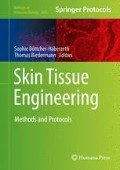Abstract
The success of tissue engineering hinges on the rapid and sufficient vascularization of the neotissue. For efficient vascular network formation within three-dimensional (3D) constructs, biomaterial scaffolds that can support survival of endothelial cells as well as formation and maturation of a capillary network in vivo are highly sought after. Here, we outline a method to biofabricate 3D porous collagen scaffolds that can support extrinsic and intrinsic vascularization using two different in vivo animal models—the mouse subcutaneous implant model (extrinsic vascularization, capillary growth within the scaffold originating from host tissues outside the scaffold) and the rat tissue engineering chamber model (intrinsic vascularization, capillary growth within the scaffold derived from a centrally positioned vascular pedicle). These in vivo vascular tissue engineering approaches hold a great promise for the generation of clinically viable vascularized constructs. Moreover, the 3D collagen scaffolds can also be employed for 3D cell culture and for in vivo delivery of growth factors and cells.
Access this chapter
Tax calculation will be finalised at checkout
Purchases are for personal use only
References
Yannas IV, Tzeranis DS, Harley BA, So PTC (2010) Biologically active collagen-based scaffolds: advances in processing and characterization. Philos Trans A Math Phys Eng Sci 368:2123–2139
Abou Neel EA, Bozec L, Knowles JC et al (2013) Collagen—emerging collagen based therapies hit the patient. Adv Drug Deliv Rev 65:429–456
Shoulders MD, Raines RT (2009) Collagen structure and stability. Annu Rev Biochem 78:929–958
Chan EC, Kuo S-M, Kong AM et al (2016) Three dimensional collagen scaffold promotes intrinsic vascularisation for tissue engineering applications. PLoS One 11:e0149799
Zhan W, Marre D, Mitchell GM et al (2016) Tissue engineering by intrinsic vascularization in an in vivo tissue engineering chamber. J Vis Exp. https://doi.org/10.3791/54099
Wan Y, Xiao B, Dalai S et al (2009) Development of polycaprolactone/chitosan blend porous scaffolds. J Mater Sci Mater Med 20:719–724
Lim SY, Hsiao ST, Lokmic Z et al (2012) Ischemic preconditioning promotes intrinsic vascularization and enhances survival of implanted cells in an in vivo tissue engineering model. Tissue Eng Part A 18:2210–2219
Scherle W (1970) A simple method for volumetry of organs in quantitative stereology. Mikroskopie 26:57–60
Acknowledgments
The authors declare no conflict of interest. This work was supported by grants from The National Health and Medical Research Council of Australia (NHMRC#1061912), Rebecca L Cooper Medical Research Foundation, St Vincent’s Hospital (Melbourne) Research Endowment Fund, and Stafford Fox Medical Research Foundation. J.H.W. received a R.B. McComas Research Scholarship in Ophthalmology, Gordon P Castles Scholarship, and a Melbourne Research Scholarship. The Centre for Eye Research Australia and the O’Brien Institute Department of St Vincent’s Institute of Medical Research received Operational Infrastructure Support from the Victorian State Government’s Department of Innovation, Industry and Regional Development.
Author information
Authors and Affiliations
Editor information
Editors and Affiliations
Rights and permissions
Copyright information
© 2019 Springer Science+Business Media, LLC, part of Springer Nature
About this protocol
Cite this protocol
Wang, JH., Chen, J., Kuo, SM., Mitchell, G.M., Lim, S.Y., Liu, GS. (2019). Methods for Assessing Scaffold Vascularization In Vivo. In: Böttcher-Haberzeth, S., Biedermann, T. (eds) Skin Tissue Engineering. Methods in Molecular Biology, vol 1993. Humana, New York, NY. https://doi.org/10.1007/978-1-4939-9473-1_17
Download citation
DOI: https://doi.org/10.1007/978-1-4939-9473-1_17
Published:
Publisher Name: Humana, New York, NY
Print ISBN: 978-1-4939-9472-4
Online ISBN: 978-1-4939-9473-1
eBook Packages: Springer Protocols

